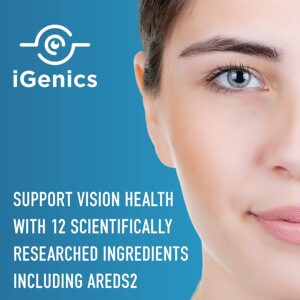Your eyes are among the most delicate and vital organs in your body. They rely on a steady flow of oxygen- and nutrient-rich blood to function properly. Good circulation keeps the retina healthy, supports the optic nerve, and maintains sharp vision. When eye blood flow is restricted, problems like blurry vision, eye strain, dark circles, and even serious conditions such as glaucoma or macular degeneration can develop over time.
Fortunately, there are many natural ways to boost eye circulation and clarity without relying solely on medication. From lifestyle adjustments and nutrient-rich foods to eye exercises and herbal remedies, improving blood flow to your eyes can enhance both their health and performance.
In this comprehensive guide, we’ll explore science-backed, holistic methods to strengthen your eye circulation and keep your vision crystal clear for years to come.
1. Why Eye Circulation Matters for Vision Health
The eyes are one of the most metabolically active organs in the human body, meaning they need a constant supply of oxygen and nutrients. Proper circulation delivers these essentials while removing waste products like carbon dioxide and toxins.
When blood flow to the eyes is restricted, it can lead to:
- Blurred or cloudy vision
- Eye fatigue and strain
- Poor focus and visual clarity
- Cold or tired eyes
- Increased risk of retinal or optic nerve damage
Chronic poor circulation may even contribute to degenerative eye conditions such as glaucoma, retinopathy, and macular degeneration. Supporting healthy blood flow is therefore key to protecting your vision and maintaining overall eye wellness.
2. Common Causes of Poor Eye Circulation
Several factors can negatively impact blood flow to the eyes, including:
- Sedentary lifestyle: Lack of movement reduces overall circulation.
- High blood pressure or cholesterol: These conditions narrow blood vessels, including those in the eyes.
- Smoking and alcohol: Both impair blood vessel function and oxygen delivery.
- Poor diet: Deficiency in nutrients like omega-3s, vitamins, and minerals weakens blood vessels.
- Stress and eye strain: Tight muscles around the eyes can reduce oxygen flow.
- Aging: Blood vessel elasticity decreases naturally with age.
Identifying and managing these factors early can make a huge difference in your long-term vision health.
3. Eye Exercises to Stimulate Blood Flow
Just as you exercise your body to boost circulation, you can also perform simple eye exercises to improve blood flow and reduce fatigue.
1. Eye Massage:
Gently rub your palms together to warm them, then place them over your closed eyes for 30 seconds. The warmth relaxes the muscles and encourages blood flow.
2. Eye Rolling:
Slowly roll your eyes clockwise and counterclockwise 10 times each. This movement stimulates circulation in the small blood vessels around your eyes.
3. Blinking Exercise:
Blink rapidly for 30 seconds, rest, and repeat three times. Frequent blinking helps spread tears evenly, preventing dryness and strain.
4. Focus Change:
Hold a pen or finger about 10 inches from your face. Focus on it for a few seconds, then shift your focus to an object farther away. Repeat 10 times. This strengthens the ciliary muscles and boosts retinal blood flow.
Performing these exercises daily enhances flexibility and oxygen delivery to your eye tissues.
4. Nutrient-Rich Foods That Enhance Eye Circulation
Diet plays a massive role in maintaining healthy blood flow and visual clarity. Including eye-boosting nutrients in your meals can nourish the retina, reduce oxidative stress, and strengthen blood vessel walls.
Best Foods to Improve Eye Circulation:
- Fatty Fish (Salmon, Mackerel, Sardines): Rich in omega-3 fatty acids, which improve microcirculation and protect the retina.
- Leafy Greens (Spinach, Kale, Collard Greens): High in lutein and zeaxanthin—powerful antioxidants that protect blood vessels in the eyes.
- Citrus Fruits (Oranges, Grapefruits, Lemons): Packed with vitamin C, essential for maintaining blood vessel elasticity.
- Beets and Beet Juice: Contain nitrates that help dilate blood vessels and improve circulation to the optic nerve.
- Blueberries and Blackberries: Rich in anthocyanins that strengthen capillaries and protect the retina.
- Carrots and Sweet Potatoes: Excellent sources of beta-carotene, which supports retinal health.
- Garlic and Onions: Contain sulfur compounds that help lower cholesterol and improve blood flow.
- Nuts and Seeds (Walnuts, Flaxseeds, Chia Seeds): Provide vitamin E and omega-3s to support vascular health.
A balanced diet rich in antioxidants, healthy fats, and vitamins ensures that your eyes get the nourishment they need for optimal function.
5. The Role of Hydration in Eye Circulation
Dehydration can make your eyes feel dry, tired, and irritated. Proper hydration improves blood flow by maintaining plasma volume and nutrient transport throughout the body, including the eyes.
Tips for Staying Hydrated:
- Drink at least 8 glasses of water daily.
- Include water-rich foods like cucumbers, oranges, and watermelon.
- Limit caffeine and alcohol, as they can dehydrate the body.
Hydration not only supports eye circulation but also reduces puffiness and dark circles caused by poor fluid balance.
6. Improve Circulation Naturally Through Lifestyle Habits
Your lifestyle choices significantly affect how efficiently blood circulates throughout your body—including your eyes. Adopting healthy daily habits can dramatically enhance eye oxygenation and visual clarity.
a. Regular Exercise:
Cardiovascular activities like walking, swimming, cycling, and yoga increase heart rate, which improves overall blood flow. Even 20–30 minutes of exercise per day can help.
b. Eye-Friendly Yoga Poses:
Certain yoga poses specifically improve head and eye circulation:
- Downward Dog (Adho Mukha Svanasana)
- Shoulder Stand (Sarvangasana)
- Legs-Up-the-Wall Pose (Viparita Karani)
These poses promote oxygen flow to the head and eyes, relieve tension, and relax eye muscles.
c. Manage Stress:
Chronic stress causes blood vessels to constrict, reducing oxygen supply. Practicing meditation, deep breathing, and mindfulness can calm your body and promote better blood circulation.
d. Limit Screen Time:
Extended exposure to screens causes strain and reduces blinking frequency, which hampers tear film circulation. Follow the 20-20-20 rule: every 20 minutes, look at something 20 feet away for 20 seconds.
7. Herbal Remedies That Enhance Eye Blood Flow
Several herbs have been traditionally used to promote microcirculation and strengthen the eyes. Always consult a healthcare provider before trying herbal supplements.
Top Herbs for Eye Circulation:
- Ginkgo Biloba: Enhances blood flow to the retina and optic nerve while protecting against oxidative damage.
- Bilberry Extract: Contains anthocyanins that strengthen capillaries and improve night vision.
- Turmeric (Curcumin): A powerful anti-inflammatory that supports vascular health and reduces oxidative stress.
- Cayenne Pepper: Contains capsaicin, which stimulates circulation and promotes nutrient delivery to the eyes.
- Green Tea: Rich in catechins that protect retinal cells from oxidative stress and improve vessel elasticity.
Regular use of these herbs, whether as tea or supplements, can gently support your body’s natural eye health mechanisms.
8. Massage Techniques for Better Eye Blood Flow
Gentle facial and eye massages can greatly improve circulation and reduce tension around the eyes.
Simple Eye Massage Steps:
- Warm Compress: Apply a warm towel over closed eyes for 5 minutes to relax the muscles.
- Temple Circles: Use your fingertips to make small circles on your temples and around the eyes.
- Under-Eye Massage: Gently tap the under-eye area using your ring finger to encourage lymphatic drainage.
- Eyebrow Pressure Points: Press gently on the inner and outer corners of the eyebrows to relieve strain.
Regular massage reduces puffiness, brightens the eyes, and encourages nutrient delivery through improved blood flow.
9. Manage Blood Pressure and Cholesterol for Healthy Eyes
High blood pressure and cholesterol can constrict or damage the delicate blood vessels that feed your eyes. Over time, this can lead to vision loss or retinal complications.
To Protect Your Eye Circulation:
- Reduce sodium intake.
- Eat more fiber and omega-3-rich foods.
- Avoid processed and fried foods.
- Get regular checkups to monitor blood pressure and cholesterol levels.
Keeping your cardiovascular system healthy directly translates into better circulation for your eyes.
10. Get Enough Rest and Quality Sleep
During sleep, your body repairs and regenerates tissues—including those in your eyes. Poor sleep quality or chronic sleep deprivation can reduce blood oxygen levels, leading to dull, tired-looking eyes and blurred vision.
To Improve Sleep Quality:
- Maintain a consistent sleep schedule.
- Avoid screens 1 hour before bed.
- Use blackout curtains to create a dark, restful environment.
- Practice relaxation techniques such as deep breathing before bed.
A full night’s rest gives your eyes time to heal and replenish, ensuring better focus and clarity the next day.
11. Supplements That Support Eye Circulation
If your diet isn’t providing enough nutrients, supplements can help fill the gaps.
Best Supplements for Eye Circulation:
- Omega-3 Fatty Acids: Improve microcirculation and prevent dry eyes.
- Lutein and Zeaxanthin: Protect the retina from oxidative stress.
- Vitamin C and E: Strengthen blood vessels and reduce inflammation.
- CoQ10: Supports mitochondrial energy and vascular health.
- Magnesium: Relaxes blood vessels and improves oxygen delivery.
Always choose high-quality supplements and consult with a healthcare provider for personalized guidance.
12. The Connection Between Eye Clarity and Detoxification
Poor eye clarity is often linked to toxin buildup and sluggish circulation. Supporting your body’s detox systems can indirectly improve vision and eye brightness.
Detox Tips for Clearer Eyes:
- Eat antioxidant-rich foods (berries, green tea, leafy greens).
- Stay hydrated to flush out waste.
- Reduce sugar and alcohol intake.
- Include fiber-rich foods to promote gut health.
When your body is clean internally, your eyes often appear brighter, clearer, and more vibrant.
13. Final Thoughts: Nourish Your Eyes, Naturally
Healthy vision depends on more than just good genetics—it’s about how well you care for your eyes every day. By improving circulation through diet, exercise, hydration, and mindful habits, you can naturally enhance your eye clarity, comfort, and long-term vision health.
Small daily steps—like taking breaks from screens, eating nutrient-rich foods, or practicing gentle eye massages—can have a profound cumulative effect.
Your eyes are a reflection of your overall health. Prioritize them with consistent care, and you’ll enjoy clearer, sharper, and more vibrant vision for years to come.
>>>Click here to restore your vision with the 12-second biblical trick.



